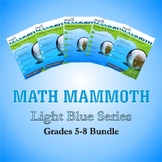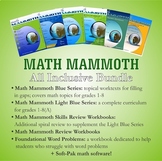Math Mammoth Grade 8 Complete Curriculum
- Zip
Also included in
- This bundle includes grades 5, 6, 7, and 8 from the Math Mammoth curriculum.Each grade level consists of two student worktexts (A and B; written directly to the student), answer keys, chapter tests, end-of-year test, additional cumulative reviews, and a versatile worksheet maker (Internet access reqPrice $112.50Original Price $167.00Save $54.50
- This BUNDLE OF BUNDLES contains these Math Mammoth products:Math Mammoth Blue series Math Mammoth Light Blue series Math Mammoth Skills Review workbooksMath Mammoth Review workbooks Math Mammoth Foundational Word Problems workbookPrice $280.00Original Price $592.45Save $312.45
Description
Math Mammoth Grade 8 is a complete math curriculum for 8th grade mathematics studies. It contains some typical algebra 1 topics, but not all (based on the Common Core Standards for 8th grade (CCS)). You could classify it as an in-between course between traditional pre-algebra and algebra 1.
At the heart of the curriculum are two student worktexts (A and B), each covering about half a year of math work. These worktexts contain all the instruction and the exercises in the same book — which makes lesson preparation a breeze. The worktexts are written directly to the student, and thus they allow many students to teach themselves and to learn directly from the books.
You will also get a separate answer key, chapter tests, additional cumulative reviews (I do recommend you use at least some of them), and a versatile worksheet maker (Internet access required) for those times when your student needs just a bit more practice.
Features
- Math Mammoth focuses on conceptual understanding. It explains the "WHY", so students can understand the math, not just learn "HOW" to do it.
- The curriculum is mastery-oriented. This means it concentrates fairly long on a topic, delving into its various aspects. This promotes conceptual understanding, as opposed to spiral curricula that often tend to jump from topic to topic too much.
- It requires very little teacher preparation.
- The curriculum has no separate teacher's manual nor is it scripted. The introduction to each chapter has some notes for the teacher concerning the material in the chapter. All the instruction is written directly to the student in the worktext.
- After each chapter introduction, you will find a list of Internet links and resources (games, quizzes, animations, etc.) that can be used for fun, illustrations, and further practice.
Overview of topics
Math Mammoth Grade 8 covers various traditional pre-algebra and algebra 1 topics, plus some geometry and statistics. The main areas of study are:
- exponent laws and scientific notation
- geometry: geometric transformations, angle relationships, and volume
- solving linear equations
- introduction to functions
- graphing linear equations and proportional relationships
- irrational numbers, square and cube roots, and the Pythagorean Theorem
- solving systems of linear equations (in two variables)
- statistics: scatter plots and two-way tables
Please also see the tables of contents (in the sample file), which will let you see the topics covered in more detail.
Introduction
In 8th grade, students spend the majority of the time with algebraic topics, such as linear equations, functions, and systems of equations. The other major topics are geometry and statistics.
We start with a study of exponent laws, using both numerical and algebraic expressions. The first chapter also covers scientific notation (both with large and small numbers), significant digits, and calculations with numbers given in scientific notations.
In chapter 2, students learn about geometric transformations (translations, reflections, rotations, dilations), common angle relationships, and volume of prisms, cylinders, spheres, and cones.
Next, in chapter 3, our focus is on linear equations. Students both review and learn more about solving linear equations, including equations whose solutions require the usage of the distributive property and equations where the variable is on both sides.
Chapter 4 presents an introduction to functions. Students construct functions to model linear relationships, learn to use the rate of change and initial value of the function, and they describe functions qualitatively based on their graphs.
In part 8-B, students graph linear equations, learn about irrational numbers and the Pythagorean Theorem, solve systems of linear equations, and investigate patterns of association in bivariate data (scatter plots).
Chapter 5 deals with the topic of graphing linear equations. Students study slope, and graph and write linear equations in slope-intercept and standard forms. They also learn about parallel and perpendicular lines.
In chapter 6, we delve into square roots, cube roots, irrational numbers, and equations involving square and cube roots. The rest of the chapter is spent studying the Pythagorean Theorem and its applications.
Next, in chapter 7, we focus on systems of linear equations. Students learn the three basic techniques for solving these and also solve a variety of problems that lead to a pair of linear equations.
The last chapter has to do with an introduction to bivariate data in statistics: scatter plots and two-way tables.
--------------------------------------------
The PDF files in this product can be filled in using a computer or a tablet (distance learning).
The student will need to use either Adobe Reader (on desktop/laptop) or a PDF app that has annotation tools (phones or tablets). Several PDF apps with annotation capabilities exist; see more details here.
--------------------------------------------
It is recommended that you not share the entire student worktext PDF files with students. Instead, it is better to just give the students a few pages at a time. Here is a simple method for extracting a few pages from a PDF file. It is done using Google Chrome.
1. Open the PDF file in Chrome.
2. Go to "Print" (Ctrl+P).
3. Print to PDF, and choose the page range.
4. Click the "Save" button.







